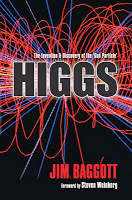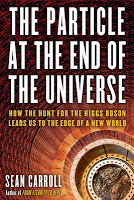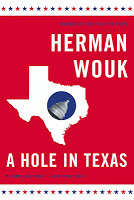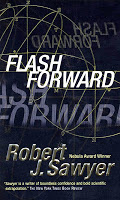This is the season for Nobel Prizes. Earlier in the week we highlighted Alice Munro’s big award. Concidentially, I had already planned a different post about Nobel Prize winners, namely the Physics prized award to Peter Higgs and Francois Englert for their work on the Higgs Boson, an aspect elementary physics that explains how elementary matter attained the mass to form stars and planets.
If like me, you are intrigued to learn more about this so called God Particle, checkout one the non-fiction titles listed below. Just for fun, there are also two related novels for your consideration.
Higgs: the invention and discovery of the ‘God particle’ (M)
by Jim Baggott
 The hunt for the Higgs particle has involved the biggest, most expensive experiment ever. So what is this particle called the Higgs boson? Why does it matter so much? What does this new particle tells us about the Universe? And was finding it really worth all the effort? The short answer is yes, and there was much at stake: our basic model for the building blocks of the Universe, the Standard Model, would have been in tatters if there was no Higgs particle. The Higgs field had been proposed as the way in which particles gain mass – a fundamental property of matter. Little wonder the hunt and discovery have produced such intense media interest. Here, Jim Baggott explains the science behind the discovery, looking at how the concept of a Higgs field was invented, how it ispart of the Standard Model, and its implications on our understanding of all mass in the Universe.
The hunt for the Higgs particle has involved the biggest, most expensive experiment ever. So what is this particle called the Higgs boson? Why does it matter so much? What does this new particle tells us about the Universe? And was finding it really worth all the effort? The short answer is yes, and there was much at stake: our basic model for the building blocks of the Universe, the Standard Model, would have been in tatters if there was no Higgs particle. The Higgs field had been proposed as the way in which particles gain mass – a fundamental property of matter. Little wonder the hunt and discovery have produced such intense media interest. Here, Jim Baggott explains the science behind the discovery, looking at how the concept of a Higgs field was invented, how it ispart of the Standard Model, and its implications on our understanding of all mass in the Universe.
The Particle at the End of the Universe: how the hunt for the Higgs boson leads us to the edge of a new world (M)
by Sean Carroll
 “When the media announced in early July 2012 that researchers had finally confirmed the existence of the elusive Higgs boson, aka the God particle, physicists around the world hailed the discovery as a major scientific breakthrough. To California Institute of Technology researcher Carroll (From Eternity to Here, 2010), the event gave another opportunity to demonstrate what he does best, translating complicated ideas into lay-friendly language. In describing how the Higgs boson was detected after decades of theoretical speculation, Carroll covers a wide swath of science, from the Big Bang to quantum mechanics, as well as the thorny politics behind funding the Large Hadron Collider in Switzerland, where experiments established the particle’s existence. Along with an overview of abstract concepts like supersymmetry, Carroll more lightheartedly explains why Hollywood loves science and why the world wasn’t likely to end if the collider inadvertently created a mini-black-hole. A first-rate physics guide that enlarges our understanding of the universe we live in” – Booklist
“When the media announced in early July 2012 that researchers had finally confirmed the existence of the elusive Higgs boson, aka the God particle, physicists around the world hailed the discovery as a major scientific breakthrough. To California Institute of Technology researcher Carroll (From Eternity to Here, 2010), the event gave another opportunity to demonstrate what he does best, translating complicated ideas into lay-friendly language. In describing how the Higgs boson was detected after decades of theoretical speculation, Carroll covers a wide swath of science, from the Big Bang to quantum mechanics, as well as the thorny politics behind funding the Large Hadron Collider in Switzerland, where experiments established the particle’s existence. Along with an overview of abstract concepts like supersymmetry, Carroll more lightheartedly explains why Hollywood loves science and why the world wasn’t likely to end if the collider inadvertently created a mini-black-hole. A first-rate physics guide that enlarges our understanding of the universe we live in” – Booklist
The Infinity Puzzle: how the hunt to understand the universe led to extraordinary science, high politics and the large Hadron Collider (M)
by Frank Close
 “Speculation is rife that by 2012 the elusive Higgs boson will be found at the Large Hadron Collider. If found, the Higgs boson would help explain why everything has mass. But there’s more at stake-what we’re really testing is our capacity to make the universe reasonable. Our best understanding of physics is predicated on something known as quantum field theory. Unfortunately, in its raw form, it doesn’t make sense-its outputs are physically impossible infinite percentages when they should be something simpler, like the number 1. The kind of physics that the Higgs boson represents seeks to “renormalize” field theory, forcing equations to provide answers that match what we see in the real world. The Infinity Puzzle is the story of a wild idea on the road to acceptance. Only Close can tell it” – publisher
“Speculation is rife that by 2012 the elusive Higgs boson will be found at the Large Hadron Collider. If found, the Higgs boson would help explain why everything has mass. But there’s more at stake-what we’re really testing is our capacity to make the universe reasonable. Our best understanding of physics is predicated on something known as quantum field theory. Unfortunately, in its raw form, it doesn’t make sense-its outputs are physically impossible infinite percentages when they should be something simpler, like the number 1. The kind of physics that the Higgs boson represents seeks to “renormalize” field theory, forcing equations to provide answers that match what we see in the real world. The Infinity Puzzle is the story of a wild idea on the road to acceptance. Only Close can tell it” – publisher
A Hole in Texas : a novel (M)
by Herman Wouk
 Still working more than 50 years after he won the Pulitzer for The Caine Mutiny, and more than 30 years after The Winds of War, Wouk, now nearly 90, has license to write what he pleases: in this case, a light, sprightly story about lost love, high-energy physics and the machinations of Washington. At 60, physicist Guy Carpenter is happily married and the father of two, including a new baby. In the late 1980s and early ’90s, he worked on the Superconducting Super Collider, a gigantic federally funded project in Texas aimed at finding the elusive Higgs bosun subatomic particle. Congress pulled the plug on the SSC in 1993-in real life as well as in the novel-professionally stranding Carpenter and leaving the Higgs bosun undiscovered. Ten years later, Carpenter has gotten his life back in order, but when a group of Chinese scientists publish a paper claiming to have discovered the Higgs bosun, his quiet existence is upended. Not only was Carpenter a key staff member on the SSC, he has sustained a secret romance since graduate school with Wen Mei Li, the chief scientist on the Chinese team.
Still working more than 50 years after he won the Pulitzer for The Caine Mutiny, and more than 30 years after The Winds of War, Wouk, now nearly 90, has license to write what he pleases: in this case, a light, sprightly story about lost love, high-energy physics and the machinations of Washington. At 60, physicist Guy Carpenter is happily married and the father of two, including a new baby. In the late 1980s and early ’90s, he worked on the Superconducting Super Collider, a gigantic federally funded project in Texas aimed at finding the elusive Higgs bosun subatomic particle. Congress pulled the plug on the SSC in 1993-in real life as well as in the novel-professionally stranding Carpenter and leaving the Higgs bosun undiscovered. Ten years later, Carpenter has gotten his life back in order, but when a group of Chinese scientists publish a paper claiming to have discovered the Higgs bosun, his quiet existence is upended. Not only was Carpenter a key staff member on the SSC, he has sustained a secret romance since graduate school with Wen Mei Li, the chief scientist on the Chinese team.
Flashforward (M)
by Robert J. Sawyer
 A team of physicists trying to prove the existence of a theoretical particle inadvertently shifts the consciousness of humankind forward 20 years. Only two minutes are “lost,” but memories of the future inspire new cults, seemingly illogical stock market speculations, and a host of new patents. Rivalry between two of the male physicists for one woman heats up, since the flash-forward has shown her to be married to the “wrong” man. One of the rivals, Lloyd Simcoe, foresees his own murder, though not his murderer. Even though the event is 21 years away, Lloyd is panic-stricken and searches worldwide for clues in the visions of others. In the end, these brief glimpses of the future prove addictive, and a new team repeats the experiment in a more controlled fashion, which treats the reader to visions of an apocalyptic, almost Wellsian future. There is also Simcoe’s sad avoidance of his own death, which he accomplishes by becoming painstakingly cautious. The reliable Sawyer turns in another solid performance
A team of physicists trying to prove the existence of a theoretical particle inadvertently shifts the consciousness of humankind forward 20 years. Only two minutes are “lost,” but memories of the future inspire new cults, seemingly illogical stock market speculations, and a host of new patents. Rivalry between two of the male physicists for one woman heats up, since the flash-forward has shown her to be married to the “wrong” man. One of the rivals, Lloyd Simcoe, foresees his own murder, though not his murderer. Even though the event is 21 years away, Lloyd is panic-stricken and searches worldwide for clues in the visions of others. In the end, these brief glimpses of the future prove addictive, and a new team repeats the experiment in a more controlled fashion, which treats the reader to visions of an apocalyptic, almost Wellsian future. There is also Simcoe’s sad avoidance of his own death, which he accomplishes by becoming painstakingly cautious. The reliable Sawyer turns in another solid performance




